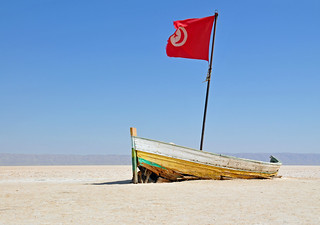Gwen Wilson, British Red Cross hygiene promoter delegate, has been in Tunisia for a week and is there to help in the camps serving thousands of people fleeing civil war in Libya. Here, she reports back on what she is seeing and how the situation is evolving:
Although new arrivals across the border had decreased substantially a couple of days before I arrived (down from 10,000 to 2,000 a day), they have increased again – last Wednesday 6,500 arrived and a couple of people had gunshot wounds.
I’m currently working at a camp for 17,000 people, which was set up by the UN High Commission for Refugees (UNHCR) – where they are building 300 latrines.

Refugee from Libya getting water from a puddle
The sanitation situation in the camp is difficult, there are limited water supplies, especially for latrines so it’s not possible to organise cleaning of latrines at the moment.
I’m focusing on hygiene promotion and I’m looking at the issue of hand washing facilities, which are lacking. One thing I asked our technical team back in the UK to advise me on is to find out if sand is as effective as ash as a substitute for soap – as sand is one thing we are not in short supply of out here!
Our health adviser gave this response: “Hand washing with soap decreases the risk of diarrhoeal diseases and is critical in hand washing as the best cleaning agent. A few reviews have demonstrated that some substitutes (sand, ash, mud) are as equally effective as soap in removing faecal coliforms from hands when used properly. However, some of these substitutes can be too harsh on the skin and can damage the outer surface of the skin and lead to skin problems. Whichever method is used, appropriate hand washing techniques should be taught/used and the skin properly dried. In the short term, sand can be used as an alternative but it should always be used in combination with water and not alone.”
At the moment the camps are being used mostly as a transit place for those fleeing Libya – as the majority are not actually Libyan refugees but migrant workers escaping the escalating violence. As yet, the reason why there are not more Libyans fleeing the country remains unclear.
Many of the migrants arrive at the camp utterly exhausted after gruelling journeys, but they only stay for a few days until they can organise to get back to their home countries. However, for some like those from Somalia and Eritrea the camp may not be merely a transit place, and they may end up staying longer.
Within the UNHCR camp, they are thinking of making a separate area for those people so they become more of a community and can cook for themselves and get on more with daily life.
Food in the camp is becoming an issue – many local Tunisians have been providing food, but that is understandably drying up and not sustainable – they could not continue to provide food for thousands of people. When I arrived I saw people queuing for 5/6 hours for meals. There’s not much food at all available to buy near the camp, and addressing the issue of food is clearly an urgent priority.
Apart from the transit camps there are also thousands of people waiting for flights at the airport. It has become a sort of camp and there are very limited toilet and washing facilities and some people are there for days so I will also be doing some hygiene promotion work there.
The International Federation of Red Cross and Red Crescent Societies, working with the Tunisian Red Crescent, is also in the process of constructing a camp for up to 10,000 people. It should be ready soon and so this is another place where I will also be involved in looking at the hygiene and sanitation situation.
There is a lot of work to be done out here but we are all working together – people from different nationalities and different organisations – to do as much as we can for the thousands of people fleeing from a desperate situation.
But my last word has to go to the Tunisian Red Crescent volunteers who are doing an excellent job under very challenging circumstances and I’m so impressed by their commitment.






![[Asmaa Elourfi] Some Benghazi residents are criticising authorities for spending money on culture instead of other priorities.](http://magharebia.com/awi/images/2013/04/19/130419Feature1Photo1-271_179.jpg) In pursuit of better health, Tunisians are visiting thermal, mineral and seawater spas and adding pricey bottled water to their family budgets. And with no limit to the natural resource, entrepreneurs see boundless opportunity.
In pursuit of better health, Tunisians are visiting thermal, mineral and seawater spas and adding pricey bottled water to their family budgets. And with no limit to the natural resource, entrepreneurs see boundless opportunity.

 Surface water resources in Tunisia are characterized by problems of quantity and quality. These resources are limited because of the semi-arid to arid climate found in most of the country, with episodic droughts, and a natural deterioration of water quality because of the salty types of rocks found within the country.
Surface water resources in Tunisia are characterized by problems of quantity and quality. These resources are limited because of the semi-arid to arid climate found in most of the country, with episodic droughts, and a natural deterioration of water quality because of the salty types of rocks found within the country.


